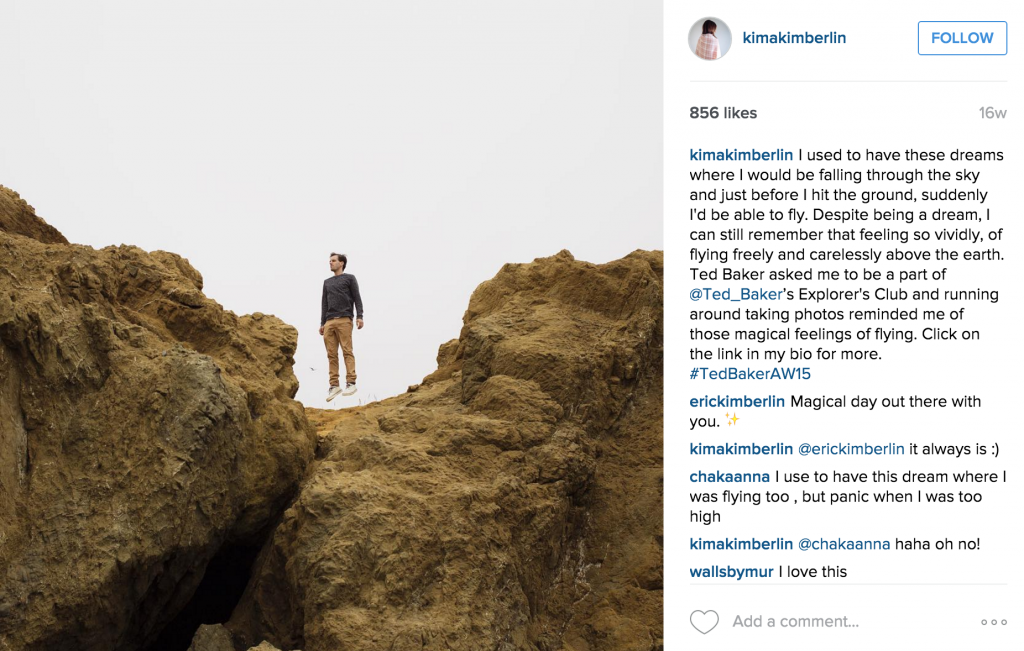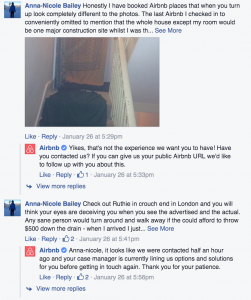
Content marketing: Two very different strategies, two very similar outcomes.
Ted Baker and Airbnb offered two very different yet similar digital marketing campaigns. One focusing on the brands experiences, one focusing on customer experiences. Do both campaigns prevail? What does this mean for brands who compose strategies, should we be focusing on the customer or the brand?
Social media outlets are now paramount to harbouring relationships with consumers (Vries et al., 2012; SAS HBR, 2010). Brands must question their integrity, authenticity and target market when going global or launching social media campaigns in targeted areas.
Ted Baker
Ted Baker, a British clothing brand, launched a North-American specific digital marketing campaign, attempting to reach into American markets.
The initiative enlisted the employment of six travel photographers (or photo-bloggers) each of these individuals having 50,000 or more Instagram followers.
These photo-bloggers then travelled across North America, tagging, hash-tagging and checking-in “wondrous, unexpected” places across North America, in key spots were Ted Baker were to target. Along with product placement (through Instagram posts) in un-penetrated areas, the bloggers were hash-tagging #TedBakerAW15.
Enlisting the enrolment of individuals with already a large digital following, these individuals created large volumes of interaction through their posts, in locations Ted Baker wish to target; creating excitement, engagement and interaction with new audiences.
Ted Bakers global communications director, Craig Smith noted “‘Explorer’s Club’ helps the brand engage and interact with both dedicated followers and a new audience that it may have not been able to reach before”. Moreover, Smith indicated “It is about making more people aware of the brand and the exciting and innovative activities Ted is constantly doing” (Smiley, 2015).
This is a campaign focusing on content generated by influencers, not user generated content.
This digital campaign is related to relationship marketing, a platform were brands “make connections” instead of “trying to sell” (Gordhamer, 2009). However, content that is generated by influencers instead of users may create a lack of integration, diminishing the initiation of a creating a brand community where consumers can interact with an organisation by direct engagement with the brand (McAlexander et al., 2012; Muñiz & O’Guinn, 2001).
Airbnb
In 2014 Airbnb launched a digital campaign (through a soon to be viral video) called “Wall and Chain”, telling the story of a woman named Cathrine, who in 2012 brought her father, Jörg, back to Berlin for the first time since the wall had fallen. The father had been a guard in West Germany, leaving before the fall. Airbnb CMO Jonathan Mildenhall indicated, “Great content and storytelling is so important now for any brand. As a community-driven company, we don’t want to just talk about our product, but instead put our community front and centre of any campaign”. “Stories like Jörg’s bring our mission of belonging to life, and capture the spirit of Airbnb, in a totally unique and authentic way” (Plautz, 2014).
Thanks to its sui generis, the video racked up more than 5.7 million YouTube views in its first month online, establishing Airbnb as a go-to travel company for experiences (Wegert, 2014). The video was aesthetic and creative, specific enough to be believable but universal enough to be relevant, creating brand awareness and content engagement (Handley, 2015).
This campaign created psychologically appealing content, communicating integrity and credibility into Airbnb’s motives, a persuasive technique to entice consumers to stop, explore and interact with the brand (Constantinides, 2004).
Adverts or viral videos that are perceived to be exciting have a positive effect on attitude toward the brand creating a desire to react and interact (Taylor et al., 2011; Raney et al., 2003).
Comparing the two initiatives
The compelling difference between Ted Baker’ s and Airbnb’s digital campaigns is the empathy and relevance to customers that the brand creates. Ted Baker uses bloggers to promote their brand, utilising individuals who already have a following online who become representatives to the Ted Baker brand. On the contrary, Airbnb uses a customers story to promote their brand, being inspired by a consumer causes a integration between brand-to-consumer.
The difference of etiquette between Ted Baker and Airbnb can be seen through their customer integration on Facebook. You can not pass a user generated post or comment on Airbnb’s Facebook without a direct response to the consumer from Airbnb.
However, Ted Baker have zero brand-to-consumer interaction, every post and comment is dismissed, complaints from consumers ousted, which can only offend the consumer more.
See for yourselves: Airbnb Facebook, Ted Baker Facebook
Interactivity between brand and consumer is important, motivating and welcoming followers to interact creates an optimum level of interactivity (Fortin & Dholakia, 2005).
Discussion
(Ted Baker)
- Should be more customer empathetic and focused. Ted Baker wanted consumers to know about the innovative and exciting things it was doing. This is not customer orientated. Nowadays consumers want to be an aficionado about a brand, Ted Bakers campaign diminishes that opportunity.
(Airbnb)
- Although being vocal through Facebook to consumers is a positive approach, this is time consuming and costly. Furthermore, once its apparent that replies will be made almost immediately, this forum on Facebook is only going to grow, this means sifting through the meaningless and sometimes fake posts that social media can foster.
Similarities
Even though the differences of these strategies are substantial, connections arise. The two brands are capturing the attention of local people through local places. It seems the best way to emerge markets and promote yourselves in different countries is to create a buzz around that place, customers like to be noticed closer to home, when brands co-sign and demonstrate positive things about places people reside, it is welcomed.
Two very different strategies, two very similar outcomes.
Recommendations
For brands that want to emerge in new markets (or) locations, it is recommended:
- Engage with consumer in the market (or) place you’re trying to target.
- Although it maybe time-consuming and costly, a strong interaction through local social media sites is meaningful.
References
Constantinides, E. 2004, “Influencing the online consumer’s behaviour: the Web experience”, Internet Research,vol. 14, no. 2, pp. 111-126.
Fortin, D.R. & Dholakia, R.R. 2005, “Interactivity and vividness effects on social presence and involvement with a web-based advertisement”,Journal of Business Research, vol. 58, no. 3, pp. 387-396.
Gordhamer, S. 2009. “4 Ways Social Media is Changing Business”. [Online] 22 September. Available at: http://mashable.com/2009/09/22/social-media-business/#w7us4cMJokq5. [Accessed 27 January 2016].
Handley, A. 2015. 6 Recent Marketing Campaign That Were Pretty Awesome. Entrepreneur. [Online] 3rd May. Available at: http://www.entrepreneur.com/article/244504. [Accessed 31 January 2016].
McAlexander, J.H., Schouten, J.W. & Koenig, H.F. 2002, “Building Brand Community”, Journal of Marketing, vol. 66, no. 1, pp. 38-54.Muniz, ., Albert M & O’Guinn, T. 2001, “Brand Community”, Journal of Consumer Research, vol. 27, no. 4, pp. 412-432.
Plautz, J. 2014. Airbnb turns a touching Berlin Wall anniversary story into ad campaign. Mashable UK. [Online] 7th November. Available at: http://mashable.com/2014/11/07/airbnb-berlin-wall/#hPQAV18ziOql. [Accessed 30 January 2016].
Raney, A.A., Arpan, L.M., Pashupati, K. & Brill, D.A. 2003, “At the movies, on the Web: An investigation of the effects of entertaining and interactive Web content on site and brand evaluations”, Journal of Interactive Marketing, vol. 17, no. 4, pp. 38-53.
SAS HBR. 2010. “The new conversation: Taking social media from talk to action”. Harvard Business Review Analytic Services. pp. 1 – 24.
Smiley, M. 2015. Ted Baker enlists help of social influencers for first North American campaign. [Online] 25 September. Available at: http://www.thedrum.com/news/2015/09/25/ted-baker-enlists-help-social-influencers-first-north-american-campaign. [Accessed 27 January 2016].
Taylor, G. Lewin, J. Strutton, D. 2011. “Friends, Fans and Followers: Do Ads Work on Social Networks?”. Journal of Advertising Research, vol. 51, no. 1, pp.258-275.
Vries, L.d., Gensler, S. & Leeflang, P.S. 2012, “Popularity of Brand Posts on Brand Fan Pages: An Investigation of the Effects of Social Media Marketing”, Journal of Interactive Marketing, vol. 26, no. 2, pp. 83.
Wegert, T. 2014. How Airbnb is using content marketing to stay on top. Contently. [Online] 5th December. Available at: https://contently.com/strategist/2014/12/05/how-airbnb-is-using-content-marketing-to-stay-on-top/ [Accessed 29 January 2015].



